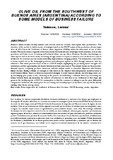Olive oil from the Southwest of Buenos Aires (Argentina) according to some models of business failure

View/
Date
2025-04-07Author
Palabras Clave
Extra virgin olive oil, outhwest of Buenos Aires Province, SWOT, financing, cluster, ArgentinaExtra virgin olive oil, Southwest of Buenos Aires Province, SWOT, financing, cluster, Argentina
Huile d'olive, sud-ouest de Buenos Aires, FOFD, financement, cluster, Argentine, Azeite de oliva, sudoeste de Buenos Aires, POFA, financiamento, cluster, Argentina
Metadata
Show full item recordAbstract
Business failure models identify intrinsic and external elements of firms that explain their performance. The objective of the work is to build a matrix of strategies based on the SWOT matrix of the production of extra virgin olive oil (EVOO) in the Southwest of Buenos Aires, Argentina (SWBA) within the framework of one of these models. This sector forms a regional and sectoral cluster that translates into advantages for its members, such as joint purchases, and better access to training and technical advice, among others. However, they face disadvantages in other aspects such as access to credit, not having enough volume to export, to mention some of the sectors own, in addition to the country's macroeconomic instability (high inflation, changing policies). The information comes from a census carried out on the forty-eight producers and subsequent updates in 2023 through interviews with key references. This article presents major results as a SWOT analysis, highlighting the producing farms' strengths and weaknesses, and the opportunities and threats derivate from their environment. The analysis focuses on the economic-financial aspects, comparing producer statements with the analysis results to determine alignment with business failure theories. Finally, a Matrix of strategies is built based on the variables that entrepreneurs should monitor to avoid business failure. Based on these recommended strategies to avoid business failures, the following stands out: (i) diversifying your points of sale, advancing in the process of establishing a collective brand by overcoming the rivalry between them; (ii) increasing the number of extractors so that there is no bottleneck at that stage; (iii) promote the healthy aspects of EVOO consumption so that the consumer is willing to pay the price differential compared to traditional oils; (iv) improve the accounting and formality aspect of the farms; and (v) join the already existing Olive Route, among others.
Collections
Información Adicional
| DOI | https://doi.org/10.53766/Agroalim/2025.31.60.07 |
| Otros Títulos | Olive oil from the Southwest of Buenos Aires (Argentina) according to some models of business failure - L'huile d'olive du sud-ouest de Buenos Aires (Argentine) selon certains modèles d'échec commercial - Azeite de oliva do Sudoeste de Buenos Aires (Argentina) segundo alguns modelos de fracasso empresarial |
| Correo Electrónico | ltedesco@criba.edu.ar |
| ORCID | http://orcid.org/0000-0003-4329-7046 |
| ISSN | 1316-0354 |
| Resumen en otro Idioma | Business failure models identify intrinsic and external elements of firms that explain their performance. The objective of the work is to build a matrix of strategies based on the SWOT matrix of the production of extra virgin olive oil (EVOO) in the Southwest of Buenos Aires, Argentina (SWBA) within the framework of one of these models. This sector forms a regional and sectoral cluster that translates into advantages for its members, such as joint purchases, and better access to training and technical advice, among others. However, they face disadvantages in other aspects such as access to credit, not having enough volume to export, to mention some of the sectors own, in addition to the country's macroeconomic instability (high inflation, changing policies). The information comes from a census carried out on the forty-eight producers and subsequent updates in 2023 through interviews with key references. This article presents major results as a SWOT analysis, highlighting the producing farms' strengths and weaknesses, and the opportunities and threats derivate from their environment. The analysis focuses on the economic-financial aspects, comparing producer statements with the analysis results to determine alignment with business failure theories. Finally, a Matrix of strategies is built based on the variables that entrepreneurs should monitor to avoid business failure. Based on these recommended strategies to avoid business failures, the following stands out: (i) diversifying your points of sale, advancing in the process of establishing a collective brand by overcoming the rivalry between them; (ii) increasing the number of extractors so that there is no bottleneck at that stage; (iii) promote the healthy aspects of EVOO consumption so that the consumer is willing to pay the price differential compared to traditional oils; (iv) improve the accounting and formality aspect of the farms; and (v) join the already existing Olive Route, among others. - Les modèles d'échec commercial identifient les éléments intrinsèques et externes qui expliquent la performance des entreprises. L'objectif de cet article est de construire une matrice stratégique basée sur la matrice SWOT de la production d'huile d'olive extra vierge (EVOO) dans le sud-ouest de Buenos Aires en Argentine (SOB) dans le cadre de l'un de ces modèles. Ce secteur forme un cluster régional et sectoriel qui se traduit par des avantages pour ses membres, tels que des achats groupés, un meilleur accès à la formation et aux conseils techniques, entre autres. Cependant, ils sont confrontés à des désavantages dans d'autres domaines tels que l'accès au crédit, le manque de volume pour exporter - pour mentionner certains des désavantages spécifiques au secteur - ainsi que l'instabilité macroéconomique du pays - inflation élevée, politiques changeantes et autres. Les informations proviennent d'un recensement des quarante-huit producteurs et de mises à jour ultérieures en 2023 par le biais d'entretiens avec des acteurs clés. Les résultats sont présentés sous la forme d'une analyse SWOT mettant en évidence les forces et les faiblesses des exploitations productrices, ainsi que les opportunités et les menaces découlant de l'environnement dans lequel elles opèrent, en mettant l'accent sur les aspects économiques et financiers des exploitations, afin de vérifier si ce qui est déclaré par les producteurs et le résultat de cette analyse correspondent à ces théories de la faillite d'entreprise. Enfin, une matrice de stratégie est construite sur la base des variables que les entrepreneurs devraient surveiller afin d'éviter la faillite de l'entreprise. Parmi les stratégies recommandées pour éviter l'échec de l'entreprise, les suivantes se distinguent : i) diversifier les points de vente, avancer dans le processus de création d'une marque collective, surmonter la rivalité entre eux ; ii) augmenter le nombre d'extracteurs afin qu'il n'y ait pas de goulot d'étranglement à ce stade ; iii) promouvoir les aspects sains de la consommation d'EVOO afin que les consommateurs soient prêts à payer la différence de prix par rapport aux huiles traditionnelles ; iv) améliorer la comptabilité et la formalité des exploitations ; et, v) rejoindre la Route de l'olivier déjà existante, parmi d'autres. - Os modelos de fracasso empresarial identificam elementos intrínsecos e externos às empresas que explicam o seu desempenho. O objetivo do trabalho é construir uma matriz de estratégias baseada na matriz SWOT da produção de azeite de oliva extra virgem (AOEV) no Sudoeste de Buenos Aires, Argentina (SOB) no âmbito de um desses modelos. Este setor forma um cluster regional e setorial que se traduz em vantagens para os seus membros como compras conjuntas; melhor acesso à formação e aconselhamento técnico, dentre outros. No entanto, enfrentam desvantagens noutros aspectos, como no caso, por exemplo, do acesso ao crédito e insuficiência de volume para exportar. As informações vêm de um censo de produtores e posterior atualização por meio de entrevistas com referências importantes. Os resultados são apresentados como uma análise FOFA destacando os pontos fortes e fracos das propriedades produtoras junto com as oportunidades e ameaças derivadas do entorno no qual elas operam. A ênfase está posta nos aspectos econômico-financeiros no intuito de avaliar se o que é manifestado pelos produtores e o próprio resultado desta análise correspondem com o que propõe as teorias de fracasso empresarial. Além disso, constroi-se uma matriz de estratégias em função das variáveis que deveriam monitorar os empresários para eludir o fracasso empresarial. Dentre as estratégias recomendadas para evitar o fracasso empresarial, deve-se destacar: i) diversificar os pontos de venda, avançando no processo de construção de uma marca coletiva, superando a rivalidade interna; ii) aumentar o número de extratoras para evitar eventuais gargalos no processo; iii) promover os aspectos saudáveis do consumo de AOVE de maneira a que o consumidor esteja disposto a pagar a diferença de preço em relação aos azeites tradicionais; iv) melhorar o aspecto contábil e de formalização das unidades produtivas, e v) aderir à já existente Rota do Olivo. |
| Colación | 135-144 |
| País | Venezuela |
| Institución | Universidad de Los Andes |
| Sección | Agroalimentaria: Artículo de Investigación |





